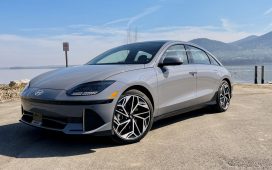Mercedes-Benz announced that it would start producing an all-electric version of its popular Sprinter van in North America and Europe starting in the second half of 2023.
The Mercedes eSprinter will have a large 113kWh battery resting under the floor between its axel, which is estimated to propel the van to a range of 248.5 miles (400 km) on highways and 311 miles (500 km) in the city, based on Europe’s WLTP standard. (The US Environmental Protection Agency is more conservative in projecting EV range.) No word yet on a suggested retail price for the van.
The van will start production at Mercedes’ Charleston, South Carolina plant later this year, which could make the eSprinter eligible for the $7,500 EV tax credit. The van will also go into production at the company’s German factories in Ludwigsfelde and Düsseldorf. The automaker has said it would only sell electric vehicles after 2030.
The Mercedes eSprinter will have a large 113kWh battery resting under the floor
There has been a dearth of general consumer electric vans in the pipeline in recent years, with most automakers training their focus on more popular segments like crossovers, trucks, and SUVs. But that looks to change, as Mercedes’ eSprinter will join the likes of the Volkswagen ID Buzz and an electric version of the Ram ProMaster when it’s released.
Like the Ford E-Transit and BrightDrop Zevo, the Mercedes eSprinter appears tailor-made for delivery operations. But unlike those vans, the eSprinter could also be repurposed for non-commercial uses — like for anyone interested in embracing a nomadic lifestyle as popularized by influencers using the #vanlife hashtag.
Or, as Mathias Geisen, head of Mercedes-Benz Vans, puts it, the eSprinter is “the most versatile Mercedes-Benz eVan ever.”
The inclusion of a larger battery is more evidence that Mercedes is hoping to target customers outside of the commercial delivery space. But for those hoping to put this van into service delivering packages, the eSprinter offers 488 cubic feet (13.8 cubic meters) of cargo space, which is commensurate with Ford E-Transit’s 487 cubic feet but significantly larger than the ID Buzz’s 138 cubic feet (3.9 cubic meters) of space.
Still, its range is what could give the eSprinter a leg up over the competitors. Ford’s E-Transit only gets 126 miles, while BrightDrop’s Zevo recently set a record for the longest trip by an electric delivery vehicle at 258 miles. Even if the EPA gives it a rating of fewer than 311 miles, the eSprinter will still look pretty competitive.
The inclusion of a larger battery is more evidence that Mercedes is hoping to target customers outside of the commercial delivery space
Mercedes says the van’s software will connect to a cloud-based “digital ecosystem,” which is another way of saying it will be eligible for over-the-air updates. The eSprinter will be built on top of the automaker’s eATS powertrain, which will be the first time Mercedes will offer a rear-axle motor for an electric van. The motor is available in two power levels, with 100kW or 150kW of peak output, and delivers a torque of up to 400 newton meters, or 295 pound-feet.
The eSprinter will be capable of both AC and DC charging, with a 9.3kW onboard charger included to help with AC charging. At a DC fast charging station, the eSprinter can accept a max charging rate of 115kW, which should take the battery from 10 to 80 percent in about 42 minutes.
The infotainment system will come standard with MBUX, the automaker’s voice-activated system, which was previously only available in Mercedes’ passenger vehicles. This latest version of the software includes dynamic route planning that will take into account charging stops, traffic, and topography when planning navigation.
As Mercedes’ first electric van targeted at the North American market and the first product aimed at general consumers, the eSprinter is notable. The company has made an electric Sprinter and a commercial electric van called eVito for a number of years, but only for customers in Europe.
It’s especially interesting coming just months after Mercedes said that its partnership with buzzy EV company Rivian would be put on hold. Rivian, which makes its EDV (electric delivery van) for Amazon and other customers, was reportedly concerned about spending a lot of money on an expensive new vehicle development project amid a slowing economy.











